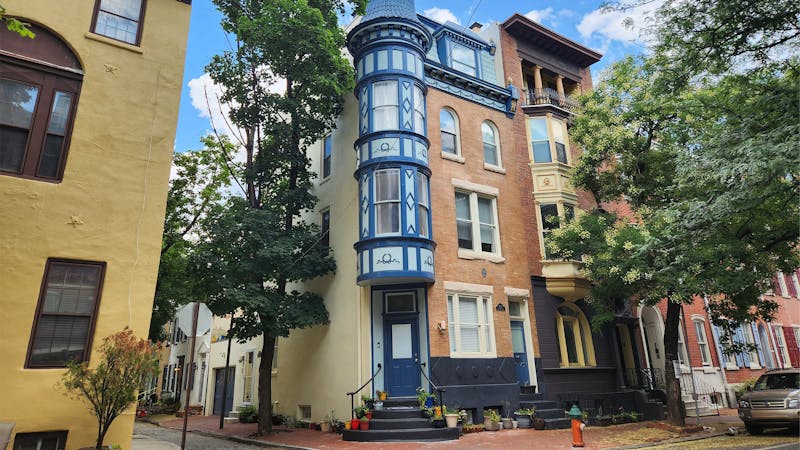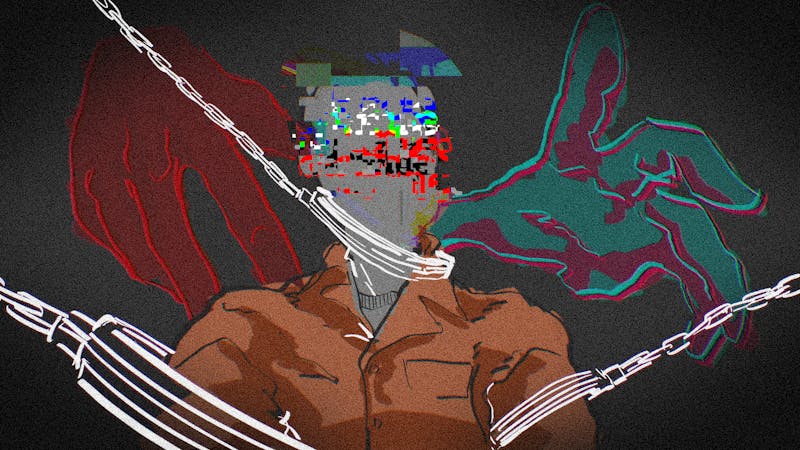Philadelphia’s bike infrastructure has long been a contentious issue. Ask any cyclist, and they’ll relay stories of weaving in and out of bike lanes due to stopped vehicles, dealing with aggressive drivers, and navigating streets littered with potholes and broken glass. But on Oct. 24, Philadelphia’s City Council unanimously passed a bill that expands and increases fines for vehicles in bike lanes and could mark a turning point in protecting cyclists.
Philadelphia is one of the worst cities for cyclists, with a cycling fatality rate greater than that of New York, Boston, San Francisco, and Chicago. In 2023, ten cyclists died in fatal traffic accidents, the most cycling–related deaths in the city since 2019.
The new bill, introduced on Sept. 5 by Philadelphia City Council President Kenyatta Johnson and Councilmember Jamie Gauthier, came after a high–profile cyclist death and pleas to improve cycling infrastructure over the summer. Amidst the calls for a more bike–friendly city come concerns from various stakeholders: businesses that require loading zones, long–term residents who call for traffic–calming measures and better maintenance, and cycling advocates who feel there is much more work to be done for safer rides.
The “Get Out the Bike Lane” bill amends Title 12 of Philadelphia’s traffic code, imposing fines on vehicles not only parked in the bike lane but also those briefly stopped. Title 12, which went into effect in 2013, allowed drivers to stop for up to 20 minutes to unload or pick someone up before the Philadelphia Parking Authority could fine them.
It’s possible for cars to pull into these lanes as most bike lanes in Philadelphia are denoted by paint, with only a handful protected by plastic flex rods. While the waist–high rods are meant to prevent vehicles from idling or parking in bike lanes, their flimsy nature allows vehicles to still enter. Chris Gale, the executive director of the Bicycle Coalition of Greater Philadelphia, a 501(c)(3) cycling advocacy and education organization, explains that the flex posts were meant to be a temporary solution until the city could install permanent bollards and cement pills. He attributes the city’s reluctance to replace flex posts with cement barriers to increased maintenance costs and the commonly held belief that the posts were sufficient.
Introducing cement bike lanes was galvanized this July by the death of Barbara Friedes, a pediatric oncologist. Friedes was biking in a bike lane protected by flexible barriers on Spruce Street when a drunk driver plowed into the lane.
Philadelphia cyclists find that bike lanes are not fully protected. Ethan Plague (C ‘25), a staffer at the Daily Pennsylvanian, bikes along Spruce to his 10:15 a.m. class. Typically, he has to pass at least four cars that are in the bike lane. In Philadelphia, cyclists have to navigate a host of vehicles such as delivery trucks, ride shares, and moving vans in the bike lanes. When Ethan sits down with Street, he has several recent scapes on his face from a cycling accident that protected bike lanes could have prevented. A bus that stopped in the bike lane forced him to maneuver around it. His bike wheel got stuck in the groove of trolley tracks lining the middle of the street, bucking him off of his bike and face–first onto the asphalt.
“I prefer streets with bike lanes. That just makes me feel more safe,” says Ethan.
Protected bike lanes are just one change Ethan wishes to see in bike infrastructure and culture in Philly. However, Ethan is doubtful about how much protection bike lanes with plastic flex rods can offer. He voices frustration about electric bikes using bike lanes, bikes or scooters that go the wrong way, and aggressive drivers, especially those who speed through red lights.
Sage Eanet (C ‘25) has a similar experience biking in West Philadelphia. Living a 30–minute walk from some parts of campus, they often bike to class or the grocery store. While they enjoy biking, cars stopped in bike lanes can disrupt their rides. “I don’t think I’ve ever biked down Spruce and not had to weave around double–parked cars,” they say.
In fact, they also were in a bike accident when an Amazon truck was double parked in the bike lane. Their wheel got stuck in the trolley groove, and they were thrown from their bike onto the ground. Sage explains that no one was on the road and that they were able to walk away from the mishap in OK physical condition. “Those sorts of things are just not my favorite,” they say with a laugh.
A large network of Philadelphians and Penn students cycle recreationally. Andrew Gray (C ‘25), president of Penn’s Cycling Club, is a serious triathlete. His advice for biking in the city? Get out.
“I would always recommend leaving the city if you’re going to bike, just because the city is not optimal for biking,” he says. Andrew often leaves the city for a loop near the airport which is seldom used by motor vehicles. In regards to cycling in the city, he says riders need to compartmentalize risk. “There’s a certain point [where] you just have to not care about certain risks, or minimize the prevalence of that risk in your head in order to get good practice [in] and enjoy it.”
Making Philadelphia safer for cyclists is no easy feat. Several city departments, such as the Department of Streets and the Office of Transportation and Infrastructure Systems are involved in maintaining and updating streets. They devote budgets and time to maintaining aging roads along with developing new bike infrastructure. These departments are invested in keeping residents safe even if swift improvements aren’t visible.
Megan Ryerson, a professor of city and regional planning and electrical and systems engineering at Penn, often works with city departments to make streets safer for cyclists. “Every time I meet city officials from any of these offices, they get it. They get it to their absolute core. They know what needs to be done. They know the on–the–ground experience.” Ryerson, who is also the UPS Foundation Chair of Transportation, explains that projects can stall when officials run up against budget restraints when trying to create new lanes or improve existing ones. Additionally, concerns of business owners advocating for loading zones and parking can prevent the implementation of new bike lanes.
Still, Ryerson supports the Get Out the Bike Lane bill and views bike lanes as a vital part of urban infrastructure. In her own research, she’s found that beyond reducing bicycle crashes, serious injuries, and deaths, bike lanes can significantly reduce the cognitive load and stress cyclists experience while commuting. Recently, she was the lead author of a study collecting biometric data, such as eye tracking data, from cyclists riding in Philadelphia’s streets. “You’re just able to focus on the task at hand, rather than constantly maneuvering,” she says.
Ryerson sees the impact of bike lanes in her own personal cycling trips around the city. “When I’m in a protected bike lane, I’m calm, everything’s calm. When I’m out there mixing with traffic, it’s more intense, and you can just feel it.” She describes the Get Out the Bike Lane bill to make stopping in bike lanes illegal as “an excellent idea.”
“Right now, if a bike lane isn’t protected, it is effectively a loading zone. And as a cyclist, you are just weaving in and out of traffic to get around vehicles parked in the loading zone. … It creates so many conflicts with drivers and cyclists, and effectively renders a bike lane non–functional,” she says.
In addition to the proposal to prevent stopping in bike lanes, Ryerson hopes to see policies that create designated loading zones—as deliveries and ride–share cars still need space to stop—as well as traffic calming techniques, such as speed bumps and the narrowing of lanes, that protect cyclists and pedestrians alike.
Cyclist safety is inextricably linked to pedestrian safety. Philadelphia has higher rates of fatal pedestrian accidents than other major cities. On the same day as Friedes’ death, two pedestrians were hit in Philadelphia. In the afternoon, a woman was hit while crossing the street in Germantown, leaving the scene in critical condition. That evening, Christopher Cabrera, a 38–year–old man, was fatally struck by a driver under the influence of drugs while waiting to cross the street in Kensington. Many of the same traffic–calming measures, such as lower speed limits, speed bumps, and roundabouts can benefit both cyclists and pedestrians. Investing in better signage, well–maintained streets, and initiatives to prevent drivers from operating vehicles under the influence of drugs and alcohol also reduces the risk of accidents.
While infrastructure to slow traffic has benefits for pedestrians and cyclists alike, bike lanes themselves have become a heated symbol of gentrification and displacement. Bike lanes can signal to residents that a community has the attention of elected officials and developers, indicating that it is an attractive neighborhood worth investing public and private dollars in. The result is that infrastructure improvements can serve as a sign to long–standing residents—specifically those who are disadvantaged—of rising rent and displacement, rather than as something meant to serve them.
Gauthier explains her approach to road design is informed by concerns from long–time residents in her district calling for safer streets, as well as the recent calls for improving bike infrastructure.
Following the death of Cabrera and Friedes, the Bicycle Coalition, Philly Bike Action, and other cycling advocacy groups brought a petition to City Hall on Aug. 15. It had three demands: permanent concrete barrier protected bike lanes on Spruce and Allegheny streets, replacement of “NO PARKING” signage with “NO STOPPING” along bike lanes, and the end of the legacy practice of allowing cars to park in bike lanes on weekends. The petition had over 6,000 signatures and 4,000 comments. Philadelphia Mayor Cherelle Parker’s administration did not formally accept the petition when the protesters hand–delivered it to Philadelphia City Hall, with Philly Bike Action calling it a cool reception in a public statement.
Parker faced criticism for her response to cycling advocates, while city administrators felt their work on safety was not getting public recognition. The Bicycle Coalition and the city’s managing director organized a September event to update residents on Parker’s approach to bike safety, which includes evaluating the implementation of concrete pillar protected bike lanes.
Gale explained that after conversations with the administration, “Now we’ve got a commitment from the managing director and the mayor’s chief of staff and the mayor herself to pay attention to this. We also have the attention and commitment from key council members.”
For Gale and the Bicycle Coalition, the Get Out the Bike Lane bill addresses one of the August petition’s demands, representing important progress for bike safety. He says, however, the PPA, which is tasked with enforcing fines, is going to need to be visible and active in imposing a fine on vehicles in bike lanes. “We want everybody in the region to be able to get to their intended destination safely regardless of how they choose to use the street,” says Gale.
In a city known for drivers who speed through red lights—and which averages more than 100 DUI arrests per month—vehicles stopping in bike lanes is just one of many risks cyclists in Philadelphia have to navigate. Others believe the increase in fees for parking and illegalization of stopping in bike lanes will not be enough to deter drivers.
“I don’t think people are going to care. They’re going to park in bike lanes regardless,” says Andrew. “I think it just allows the enforcement arm of the PPA to get more money from drivers.”
As a recreational cyclist, he finds the most meaningful initiatives toward bike–friendly infrastructure to include making designated passageways just for bikes, such as Philadelphia’s weekly closure of Martin Luther King Jr. drive for the public to use recreationally or the car free roads through Central Park in New York.
Cycling advocates and politicians agree that there is much to be done to improve cycling infrastructure. Two of the three demands in the August petition—to install concrete pillars along bike lanes and to end the legacy practice in which the Department of Streets grants parking permits to places of worship to park cars in bike lanes—have not been met. There is movement toward installing permanent pillars, with full support from key city officials like Gauthier, and Parker’s administration has promised to evaluate the initiative.
The Bicycle Coalition continues to advocate for bike–friendly future—with an emphasis on improving infrastructure beyond Center City and West Philadelphia—their education initiatives, and statewide legislation that can make cycling safer and more accessible. “Every Philadelphian, regardless of their ZIP code, should feel safe and should be able to travel the streets of Philadelphia safely,” says Gale.
While cycling in the city still has its risks, it is the preferred—and sometimes only—means of transportation for thousands of Philadelphians. For Ryerson, she feels safest and most empowered when biking with hundreds of other people heading home from their Penn jobs. “I love leaving on my bike around five o’clock with all the doctors, the nurses, the staff, the students, grad students, and professors. We’re a platoon. We cannot be missed,” she says. “The more of us who are cycling, who are out there walking, who are out there taking transit, who are just out there engaging with the system, we’re more of a force.”





